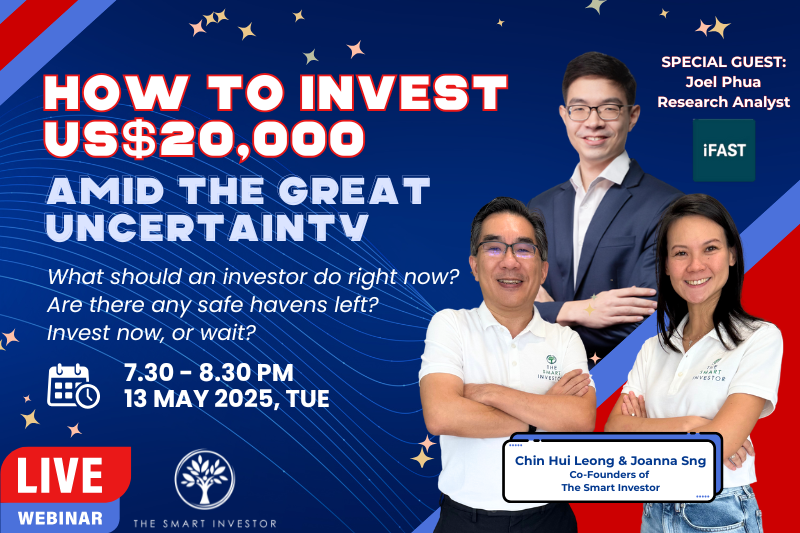Many people are worried about their retirement.
A recent survey released by insurance firm Prudential found that 20 per cent of Singaporeans foresee a delay in their retirement age to 64 years old.
Out of 1,000 respondents, close to half in the 25 to 34 age group felt unprepared.
While it is natural to rely heavily on your Central Provident Fund (CPF) to fund your golden years, it’s also crucial to consider other sources of income.
For context, CPF Life, a scheme that pays out a regular income, pays out around S$790 to S$850 per month if you set aside close to S$150,000 in your retirement account at age 65.
But with the escalating cost of living due to the highest core inflation in 13 years, you’ll need to tap on alternative sources of income once you stop working.
The Prudential survey highlighted an important fact – around two-thirds of those who were confident of retiring invested in a mix of shares, bonds, and exchange-traded funds, while slightly less than half had insurance.
In other words, both investing and insurance form the bedrock of a secure financial future.
Coupled with your active income while you can still work, these three make up the three “I” philosophy that can be used to fortify your finances.
Growing your retirement account
When it comes to building a retirement nest egg, you should not underestimate the power of your earned income.
We are fortunate to have the CPF scheme where compulsory savings allow a portion of our salaries and bonuses to be socked away into the Ordinary and Special Accounts.
When you turn 55, these two accounts will be merged into the Retirement account, which will then form the base for the CPF Life scheme that pays you a monthly income from age 65.
Salaried employees can choose to work up till 65 to continue contributing to their retirement accounts so that they can enjoy a larger payout once CPF Life kicks in.
The more you have in your CPF Retirement account, the less you will need to rely on investments to fill the gap.
Hence, earned income is a key feature of how you can prepare better for retirement.
Protecting your assets
Interestingly, the Prudential survey also highlighted the importance of insurance.
After all, there is no point in having a lot of cash and investments if these are eroded by healthcare costs relating to an accident or critical illness.
I am a strong believer in owning adequate insurance to protect my family’s assets against unfortunate events.
Being the main breadwinner, I am covered for half a million dollars for total and permanent disability (TPD) and critical illnesses.
In addition, I also have a hospitalisation and surgical (H&S) plan that covers any inpatient stay or operations should an emergency or unexpected accident occur.
And let’s not forget the value of fire insurance as we have witnessed a spate of fires breaking out in HDB flats over the last few months.
Fire insurance covers the cost of repairs and the reinstatement of damaged internal structures and fixtures, and could save you a significant amount.
Once you have adequately protected your assets, you can then invest to further grow your retirement funds.
Investing to beat inflation
Investing not only helps you to retire comfortably, but also allows you to beat inflation, too.
There are two key components to investing – growing your pool of retirement funds, and increasing your source of passive income.
The former hinges on the steady long-term capital appreciation of your investment portfolio while the latter focuses on dividends paid out by your investments.
By parking your money in strong and well-managed businesses, you can grow your portfolio at a consistent pace over years and decades.
The volatility in share prices, however, is an aspect of investing that you need to deal with.
Share prices never go up in a straight line and are affected by a myriad of factors such as macroeconomic policies, interest rates, and investor sentiment.
In the long run, share prices do track underlying business performance, which is why it’s important to buy and hold companies with sturdy competitive moats that can continue to grow their revenue and profits.
Take Adobe (NASDAQ: ADBE) for example.
The company, which is famous for its portable document format (PDF) used by organisations and individuals, has seen its share price rise nearly 14-fold in the last 13 years.
Starting at US$28 back in June 2009, the software-as-a-service provider last closed at US$387.72, for a compound annual growth rate (CAGR) of 22.4%.
Adobe’s net profit has increased more than 13-fold from US$386.5 million in 2009 to US$4.8 billion in 2021.
Visa (NYSE: V), the payments company with around 3.9 billion cards in issue, has also grown its business significantly over the years.
In the last decade, net profit has more than tripled from US$3.65 billion to US$12.3 billion.
Visa’s share price has grown nearly seven-fold over the same period, registering a CAGR of close to 21%.
Closer to home, supermarket operator Sheng Siong Group Ltd (SGX: OV8) has seen its share price jump from S$0.42 in June 2012 to S$1.55 for a CAGR of 13.9% (excluding dividends).
This result is not surprising if you consider that the retailer had grown its store count from 33 in 2012 to 64 last year, with net profit rising from S$41.7 million in 2012 to S$133.1 million in 2021.
From the examples above, it’s clear that investing in the right companies can reap superb financial rewards and help you to accelerate the growth of your retirement funds.
Building a comfortable nest egg
Aside from increasing the value of your portfolio, growing your dividend stream is an equally important aspect of building a sturdy retirement nest egg.
REITs are a popular option for income-seeking investors.
It’s a good idea to stick with more established names that have proven time and again that they can deliver.
Both Parkway Life REIT (SGX: C2PU) and Mapletree Industrial Trust (SGX: ME8U) have seen their core distributions rise without fail since their IPOs.
Mapletree Industrial Trust’s distribution per unit (DPU) increased from S$0.0841 for its fiscal 2011/2012 to S$0.138 for fiscal 2021/2022.
For Parkway Life REIT, its DPU has more than doubled from S$0.0683 in 2008 to S$0.1408 in 2021.
Under the circumstances, it makes sense to reinvest these dividends to obtain more units as you get to enjoy a double benefit – a higher number of units attracts more distributions while the rise in DPU also helps to further increase your passive income flow.
The process of compounding can accelerate your dividends flow and can be applied to any company that has a track record of steadily growing its dividends.
Your financial future is within your control
Always remember that life is a marathon and not a sprint.
You can begin by taking small steps – sourcing for a reliable financial planner, upskilling to stay relevant in your job, and putting small amounts of money into the stock market.
As time goes by, you slowly build up the competence and knowledge to grow your finances.
Your financial future is entirely within your control; all it takes is that first step.
Note: An earlier version of this article appeared in The Business Times.
First-time investors: We’ve finally released our beginner’s guide to investing. Read it in an afternoon, follow the principles, pick an investing style and buy your first SGX stocks within the next few hours! Click here to download it for free.
Follow us on Facebook and Telegram for the latest investing news and analyses!
Disclaimer: Royston Yang owns shares of Adobe, Visa and Mapletree Industrial Trust.




